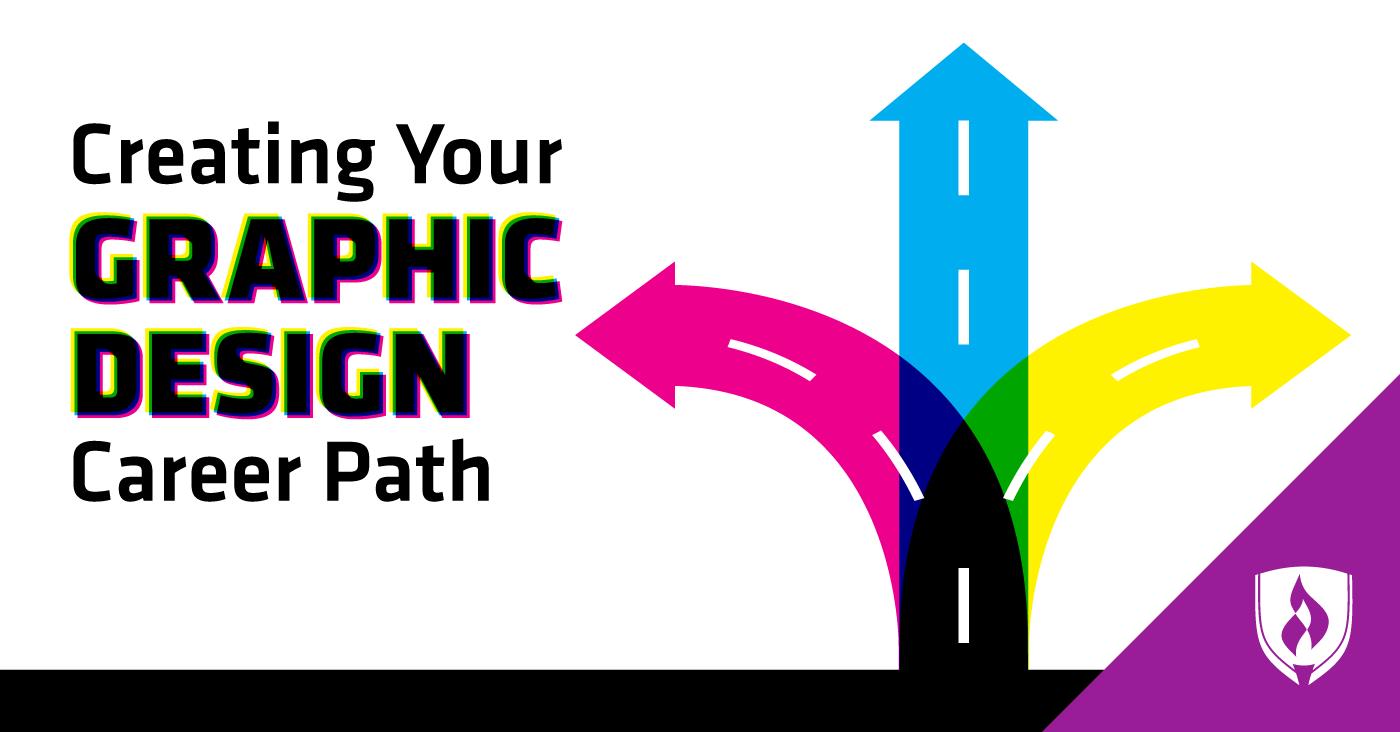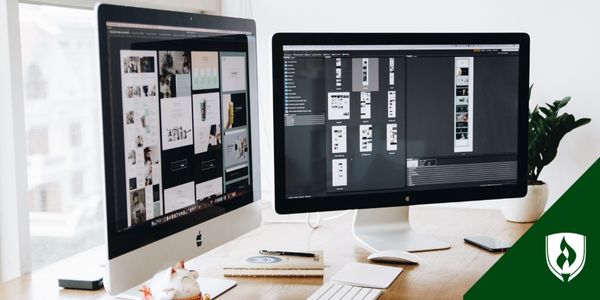
Few career paths are as customizable as graphic design. Nearly every aspect can be adjusted to fit your lifestyle and interests—from education and experience to specialty and work environment.
Creating your graphic design career path is like plugging a destination into a GPS and having the option of taking different routes. Or like making yourself a dinner out of the ingredients you like best. You can add or take out parts of the career trajectory to fit your life and schedule.
But with so many options, it can be a little overwhelming trying to figure out what works best for you. Wouldn’t it be nice to have someone tell you what your options are? To help you map out your potential graphic design career path, we’ve laid out some of the important options or choices you’ll need to consider—and asked design pros to weigh in.
Customizing your graphic design career path: 5 Factors to consider
There’s a lot that goes into shaping your graphic design career—the following five factors will play a big role in where your design future takes you.
1. Education
The choice to pursue a formal education is one of the biggest factors you’ll weigh as a would-be designer. Plenty of designers say that your portfolio is the most important thing you offer when it comes to landing a job. However, formal education can go from very useful to completely necessary depending on where you want your career to be.
“I went to design school and it was the best decision I could have made,” says Charles Forster, director of engineering at Skunkworx Lab. “I learned the basics, sure, but learning how to give and receive critiques was more valuable than any of the rest of the training.” Forster adds that peer feedback will help push your work much further than working on your own—making education also an accelerated path to a powerful portfolio.
On the other hand, formal education isn’t necessary for all graphic designers—though it can be helpful—according to Adam McIntyre, co-founder of BrandPacks. “But it certainly helps you understand the fundamental concepts and reasoning behind design.”
“I started out in graphic design as a self-taught Photoshop user, only obtaining formal qualifications later in my career,” McIntyre says. “If I could go back and do things differently, I'd pursue formal training right at the beginning of my graphic design journey. In hindsight, it would've accelerated my design career.”
There is no shortage of design tutorials online that can teach you software tricks to get going, but your designs will always be stronger when you have knowledge to support your creative decisions. If you are wondering if graphic design education is important for you, ask yourself these six questions.
2. Your preferred graphic design work environment
Another factor you’ll need to consider is the graphic design work environment you’d prefer: in-house, agency or freelance. Each setting has its own pros and cons and requirements. You might find that one of these options appeals to your skills and preferences more than the others.
In general, in-house work is stable but may get repetitive working for a single organization. Agency work has a ton of variety, but can be high-pressure and deadline-driven. Working freelance allows you to be your own boss, but it takes a lot of work to keep a steady stream of clients.
“Internships really factored into my choice,” says Alvaro Flores, interactive graphic designer at Campaign Creators. Gaining some experience in different settings as a graphic designer can be the best way to make your decision.
Flores wound up choosing agency work because he felt it allowed for more creative freedom and opportunities to learn due to the collaborative nature of the team he worked with. Flores advises every starting graphic designer to research, network and try internships to really get a feel for their choices.
“I thought about the kind of work I wanted to do, and the environment I wanted to work in,” says Cristina Robinson, UI/UX designer at Three29. “For me, freelancing was stressful because I had to wear all the hats. I didn't have a team to turn to if I didn't know how to do something. My design was limited by what I knew I could code.”
Want a more in-depth breakdown of your work environment options? Check out our article, Where Do Graphic Designers Work? In-House vs. Agency vs. Freelance .
3. Finding work, finding clients
Another factor to consider in your graphic design career is how you’ll want to approach finding work. Our graphic design gurus agreed that your portfolio—both physical and digital versions—carry a lot of weight when job or client searching.
Freelancers spend lots of time amassing a client base at the beginning. Success in this branch of graphic design often comes down to a mix of flexibility and excellence. “Be versatile, but also have your own little niche or specialty that you do better than anyone else,” says George Kern, art director at Printed Pixel.
“You are not going to like or enjoy every commission or job that comes your way, but you have to be able to do them or adapt to the situation when the time comes.” Kern says if you continue to excel in a certain specific area of design, word will spread and clients will seek you for the kind of thing you do best.
Finding employment with an agency or in-house setting often means a resume with formal education, a powerful portfolio, a successful internship—or all of the above. Read about how to put together a strong case for your employment with your graphic design portfolio.
When it comes to finding those job postings, utilizing sites liked LinkedIn or Indeed is only the beginning. Many graphic design hubs feature jobs postings. Check out AIGA or any graphic design associations in your area. There are also several insider ways you can leverage the social media sites you know and love to find jobs.
4. Graphic design specialization options
There are so many facets to graphic design—you might find yourself drawn to certain parts right away, or you might grow in your awareness of the industry and discover more over time. But, either way, specializing is a great way to increase your value as a designer and spend more time doing what you like best.
“I definitely moved on to specializing in some specific things,” Kern says. “I specialize in Out-of-home (OOH) advertising and grand-format printing.” Kern eventually teamed up with a business partner and founded a successful business that maximized their abilities.
Robinson, on the other hand, began as a web designer who had more experience with the digital work of coding and creating apps. “Over time as I worked in the industry, I realized I liked designing more than coding,” Robinson says. “When I landed in my current position as a UI/UX designer and began designing more than just websites, like apps and interfaces, I knew that's what I really enjoyed doing.”
5. Career advancement
As you become more established in your design career, you’ll want to consider your route to advancement. The important thing to know is that there’s no “right” way to advance. Maybe you’d like to be in a role where you manage and oversee the work of others. Maybe you’ll stay put as an experienced graphic design generalist, or maybe you’ll pursue specialized work like UX design or motion graphics.
Forster’s specialization in UX and UI work led to management of an engineering and design team that builds digital products. Directing or managing teams of designers is definitely a great career advancement option, especially if you’d like to coach and mentor a team of designers.
If you’re a bit more introverted and aren’t fond of the business side of the field, you may opt to hone in and master a specialized skill such as user experience (UX) design or motion graphics. Or if you have an entrepreneurial mind and have a knack for the business side, you could open your own design business and call the shots.
“I would say the key turning point in my career advancement was going back and earning formal qualifications,” McIntyre says. “Once I was better able to understand the wider applications and concepts surrounding design, I became better able to operate a team and direct multiple projects. That's why these days I firmly recommend formal education to young and ambitious designers.”
Start designing your journey
Now that you’ve seen the numerous directions a graphic design career path might lead, it’s time to start designing your customized career.
“Don't be afraid to attend meetups and other graphic designing events and try to talk with people or mentors who are already in the field,” Flores says. Gaining insight from graphic designers about their own career journeys can help you navigate your own options.
If you’re leaning toward a graphic design career path where a formal education may help, you’ll want to check out the Graphic Design degree page to learn more about how Rasmussen College can fit education into your busy schedule.
Related Articles:
- Graphic Design Projects: Expert Advice for Building Your Portfolio
- 6 Things They Don’t Tell You in the Web Designer Job Description
- I Want to be a Graphic Designer But I Can't Draw...
EDITOR’S NOTE: This article was originally published in August 2012. It has since been updated to reflect information relevant to 2018.




